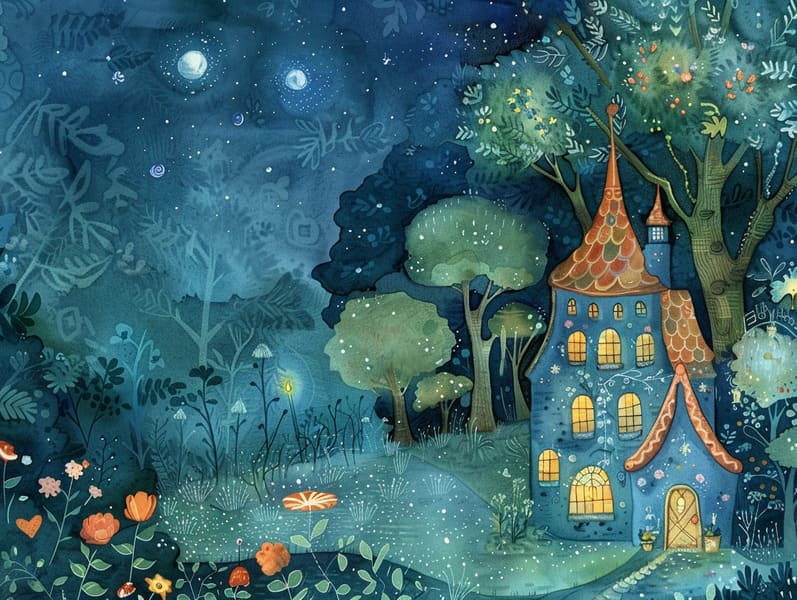
Popular fairy tales have old origins. These tales have been relayed from one generation to the next long before they were ever transcribed. They came from a variety of societies, including Asian traditions. They were initially narrated among elders, often carrying themes and messages relevant to the societal norms and beliefs of the time.
The Grimm brothers, Jacob and Wilhelm, were among the first to assemble many of these beloved fairy tales. Their compilation, "Grimm's Story Collection," included stories like "Cinderella," "Hansel and Gretel," and "The True Story of Snow White," which have since become mainstays in the world of famous fairy tales. Similarly, Hans Andersen's whimsical stories, such as "The Sea Maid," and "The Ugly Duckling," have stolen hearts worldwide, establishing their place in the pantheon of beloved fairy tales.
Though they are centuries old, these tales remain as applicable as ever, especially as bedtime stories for kids. These enchanting tales are now available in numerous formats, including richly illustrated books, captivating animations, and web-based fairy tales.
Their ongoing significance can be connected to several whimsical characteristics:
Ethical Lessons: Traditional fairy tales often convey important moral lessons. Stories like "The Shepherd Boy and the Wolf" teach the significance of truthfulness, while "The Tale of the Tortoise and the Hare" demonstrate the virtues of determination and humbleness. These stories offer children clear distinctions between virtue and vice, developing their moral compass in a mild yet profound way.
Empathy and Understanding: Timeless fairy tales frequently showcase heroines facing challenges and struggles, provoking children to connect with their struggles and support their triumphs. For instance, "Beauty's Beast" shows us the value of looking past the exterior to perceive the true essence of a being, strengthening sympathy and perception.
Cultural Comprehension: Many old fairy tales are deeply embedded in the cultural contexts from which they blossomed. Engaging with these narratives can provide delightful insights into different historical contexts, advancing a sense of global appreciation and respect.
Imagination and Creativity: The whimsical elements in traditional fairy tales—enchanted forests—trigger children’s visions and dreams. These narratives guide readers to extraordinary realms, awakening innovative dreams and a sense of curiosity that stays a lifetime.
Old fairy tales are not only spellbinding but also enlightening. They serve as fantastical tools in building various cognitive and emotional skills in children. When old fairy tales are voiced, they strengthen speech development by bringing new language and detailed sentence structures. This practice also improves auditory perception and attention, as little ones listen intently, anxious to see what happens next.
Furthermore, talking about the themes and characters of timeless fairy tales can foster intellectual skills and critical thinking. Kids are guided to see patterns, make predictions, and comprehend cause and effect. These analyses also ease little ones utter their thoughts and feelings, promoting their emotional intelligence.
In today’s high-tech era, the accessibility of digital fairy tales has made these fairy tales more obtainable than ever. Online resources and online apps present vast collections of Grimm's fairy tales that can be seen or listened on anytime, anywhere. Fairy tales read aloud are particularly prevalent, sharing an fascinating method for little ones to experience these alluring stories. Voice books and read-out-loud stories lead characters and settings to life, often accompanied by spellbinding audio effects and musical scores that amplify the storytelling experience.
The unfading fascination of classic fairy tales lies in their ability to adjust to the present while holding onto their central messages. Contemporary adaptations of these narratives often show more multicultural protagonists and modern settings, making them accessible to today’s audience. However, the fundamental themes of courage, kindness, and fairness remain unchanged, continuing to reach kids of all ages.
Timeless fairy tales also offer a sense of protection and knowability. They yield a this site methodical narrative with a evident beginning, middle, and end, often finishing with the ending of conflicts and the triumph of good over evil. This foreseeability can be calming for children, bringing a sense of stability in an unstable world.
Old fairy tales continue to mesmerize and enlighten new generations, maintaining their mystique and relevance in modern society. As bedtime stories for kids, they bring a perfect blend of allure and teaching, advancing moral values, empathy, and creativity. The proliferation of digital storybooks and the in demand status of fairy tales read out loud promise that these classic tales remain attainable to new generations.
By safeguarding and making known these stories, we continue to acknowledge the rich tapestry of cultural legacy and cultural heritage. Whether you are reading a vibrantly illustrated book, enjoying a virtual library, or playing an read-aloud book, the attraction of traditional fairy tales is always within reach. These narratives demonstrate of the steadfast impact of stories and its ability to connect us across epochs and places.
No matter if you are accessing a colorful picture book, enjoying a cyber collection, or listening on an audiobook, the charm of bedtime fairy tales is always within reach.
These narratives highlight of the perpetual force of narratives and its ability to bond us across centuries and lands, creating a bond that captivates and teaches alike.
Comments on “The Rise of Old Fairy Tales with Its Enduring Mystique.”